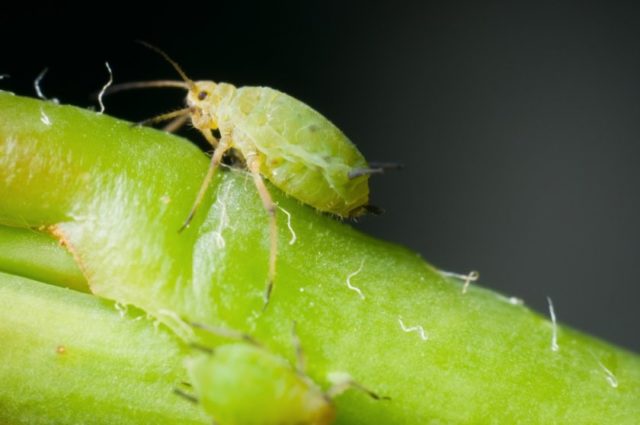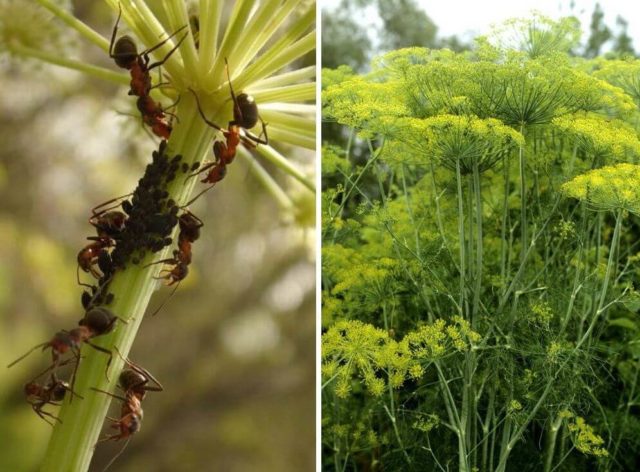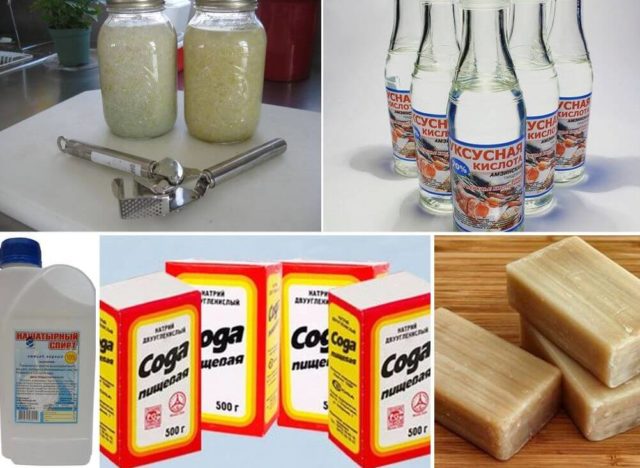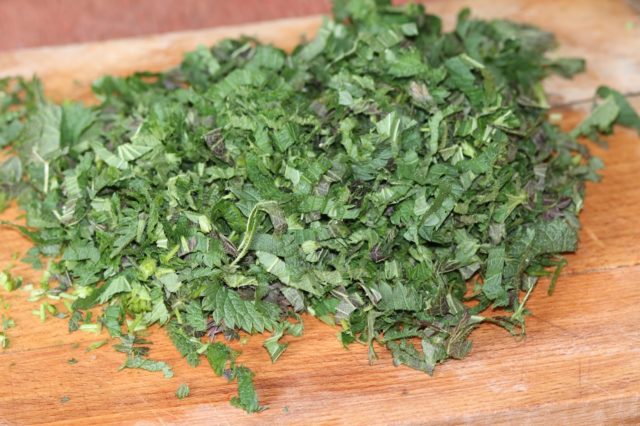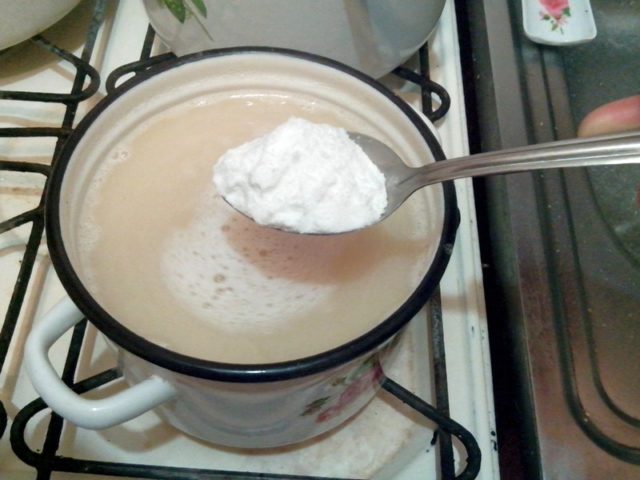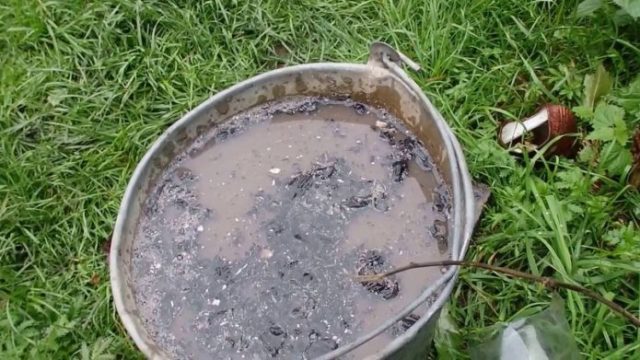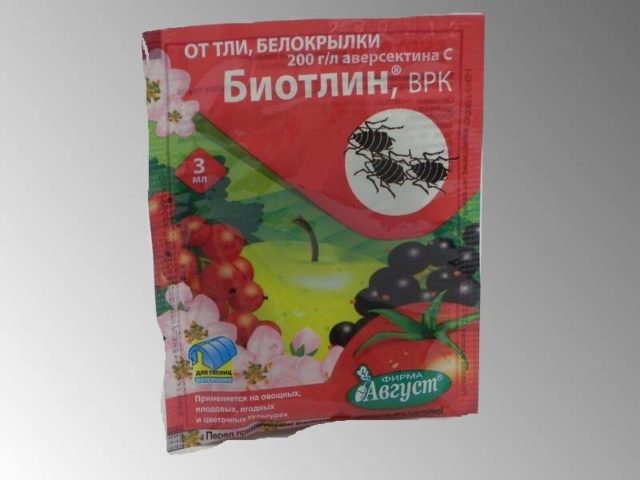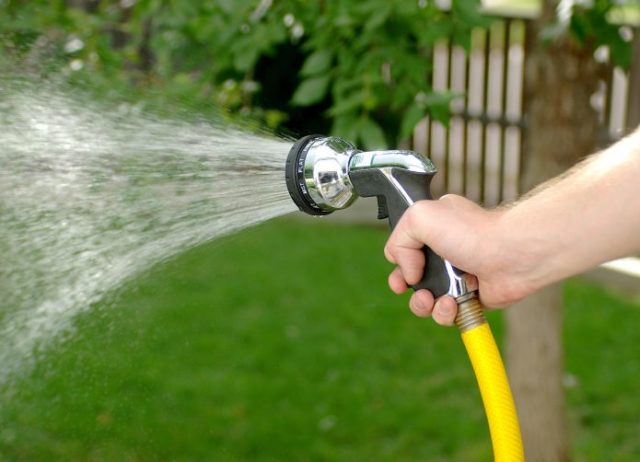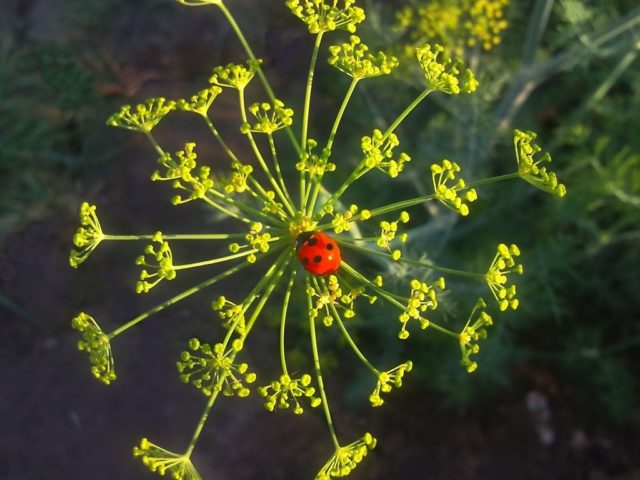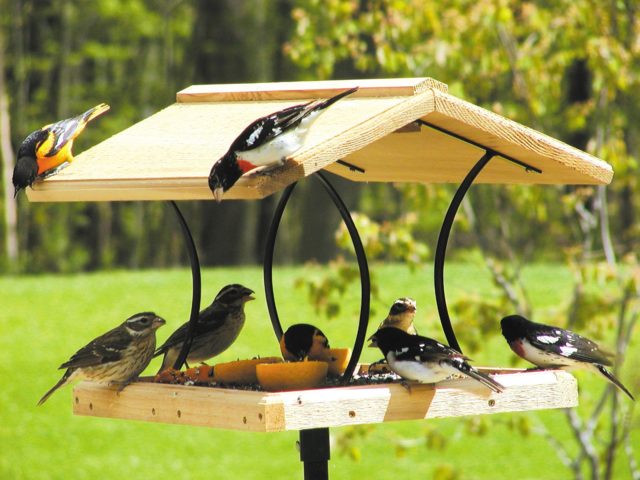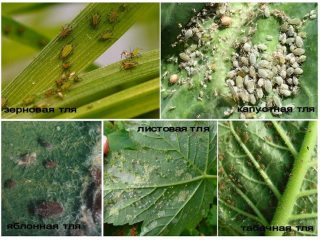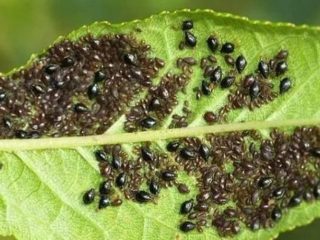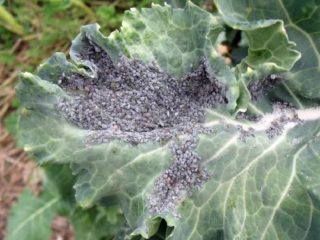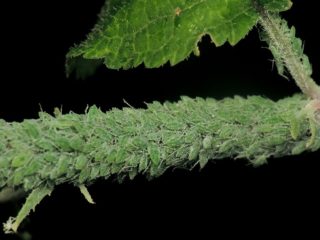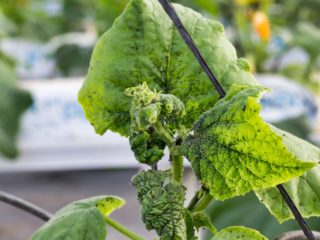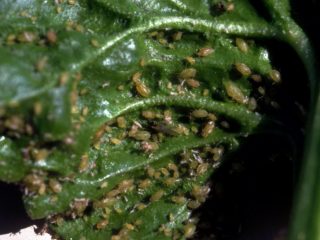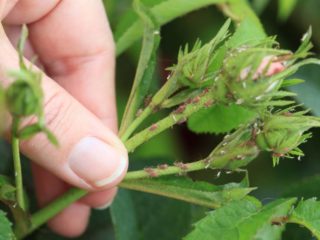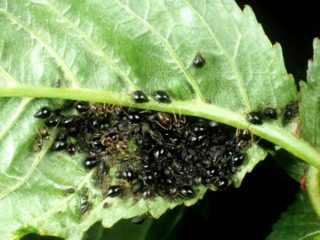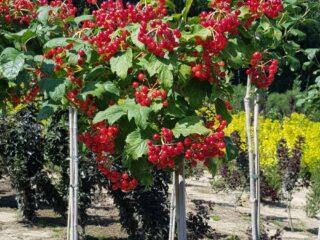Content
- 1 Reasons for the appearance of aphids on dill
- 2 Dill aphid control methods
- 3 How to deal with aphids on dill using folk methods
- 4 "Original" methods of aphid control
- 5 How to get rid of aphids on dill with biological products
- 6 Chemical treatment of dill from aphids
- 7 Physical control measures
- 8 Biological methods of aphid control on dill
- 9 What to do if aphids on cut dill
- 10 Prevention measures
- 11 Conclusion
Aphids are small insects, the body length of which does not exceed 7 mm. The life cycle of aphids begins with the emergence of the larva from the egg, usually with the arrival of heat. This insect pretty much spoils the life of gardeners. It parasitizes various plants and often leads to their death. You can get rid of aphids on dill using a variety of effective methods.
Reasons for the appearance of aphids on dill
The main reason for the appearance of aphids is common ants, which are attracted by the honeydew (sticky liquid) secreted by the aphids during their life. Ants not only consume this liquid, but also bring the larvae of harmful insects into anthills for the winter, which helps to preserve the offspring. To combat aphids, you need to get rid of the ants.
A possible reason for the appearance of aphids on dill is the successful wintering of eggs in the ground on the site.
Another reason for the occurrence of a pest on the site can be a lack of phosphorus or an excess of nitrogen in the soil under dill.
Dill aphid control methods
The harm from aphids is obvious and undeniable:
- deprives the plant of nutrient reserves, the tops of the plant are deformed and dry out;
- sticky secretions (honeydew) from aphids inhibits the process of photosynthesis and is a favorable environment for the reproduction of various fungal and viral diseases;
- attracts other pests.
Dill is most often attacked by willow-carrot aphids, which can give up to 17 generations over the summer.
Ash-like scales (old aphid shell) indicate the presence of a pest.
On closer inspection, aphids of black or green color can be found on the inside of the leaves, on shoots or umbrellas.
There are many ways, methods and preparations for protecting dill from aphids.
The fight against the pest is complicated by the fact that the culture is eaten throughout the season. Based on this, the methods and preparations used should not leave toxins after processing.
In order to get rid of aphids, use the following methods:
- folk,
- "Original";
- physical;
- biological;
- chemical agents.
With the massive appearance of aphids on dill, it is recommended to use special preparations that are safe for humans.
How to deal with aphids on dill using folk methods
You can get rid of aphids with:
- herbal decoctions and infusions that are effective and completely harmless to humans;
- enemies of aphids (for example, ladybugs).
Herbal infusions and decoctions
For small lesions of dill aphids, you can use infusions or decoctions. Re-processing of dill will be required, since the duration of the action of the infusions is shorter than that of chemicals.
Herbal infusions
The ingredients for herbal infusions are readily available and the recipes are easy to prepare. Moreover, they are effective and safe.
Nettle
Nettle contains nutrients that make dill resistant to aphids. Nettle is chopped, diluted with water and insisted for a week. The infusion is filtered and watered with dill for several days in a row.
Onion
The following infusion will help get rid of aphids. 35 g of onions are cut and, together with the husk, are kept in 1 liter of water for 5 hours. Filter and add 1 tsp. crushed laundry soap. Add water to a volume of 1 liter and spray the affected dill.
Tobacco
Due to its strong smell, tobacco helps to get rid of aphids. Dilute 200 g of tobacco in 5 liters of water. Leave for 2 days. Bring to a volume of 10 liters, filter and spray areas of dill affected by aphids.
Garlic
To prepare the infusion, pour 1 liter of cold water and chop 200 g of peeled garlic. Insist for 4 days under the lid. Add 10 g of laundry soap for better adhesion of the solution to the surface of the leaves. The resulting concentrate (25 g) is diluted with 10 l of water.
From spices
Aphids don't like strong smells. Take 20 g of red, black peppers, cinnamon and coriander and pour 2 liters of cold water. Close with a lid and insist for 1 day. Dill is sprayed on a sunny day.
Herbal
For the preparation of herbal infusion, tansy, nettle, wormwood, celandine and yarrow are suitable. The grass is finely cut and filled with water. Close the container with a lid and insist for 24 hours, filter and process the affected dill.
Chamomile
100 g of dry chamomile flowers are poured into 1 liter of water and insisted for 12 hours. For spraying, dilute the infusion with water, maintaining a ratio of 1: 3. Additionally, add 1 tsp. crushed laundry soap.
Dandelion
To get rid of aphids, it is recommended to use an infusion of dandelion tops and roots. This will require:
- 200 g dandelion foliage;
- 100 g of roots.
The flowering plant is cut finely, 10 liters of water are added. Insist 4 hours and process the resulting infusion of dill, affected by aphids.
From citrus peels
To prepare the infusion you will need:
- 100 g of peels from any citrus;
- 1 liter of warm water.
Insist for three days.
Herbal decoctions
Herbal decoctions have insecticidal properties and are effective against insect pests, including aphids.
From tomato tops
Plants of the nightshade family contain a substance called solanine in the leaves and stem, which is fatal to aphids. To get rid of insects, you need the following decoction:
- 5 kg of tomato tops;
- 10 liters of water.
The composition is brought to a boil and insisted for 0.5 hour over low heat. Before spraying, add 30 g of soap and dilute with water in a 1: 3 ratio.
Hot pepper
Required components:
- 100 g of paprika;
- 1 liter of water;
- 40 g of laundry soap.
The composition is boiled for 1 hour under the lid. Insist 2 days, filter. For spraying, dilute with water in a ratio of 1:10.
From celandine
In order to get rid of aphids, the following decoction will help:
- 0.5 kg of fresh stems, leaves and flowers of celandine;
- 1 liter of water.
Celandine is crushed and water is added. Insist for two days. The resulting broth is boiled for 30 minutes, cooled and filtered.
Soda and salt
Soda and salt are affordable and effective remedies for garden pests, including aphids.
To prepare an insecticidal agent, you need to dissolve 10 tbsp in 10 liters of water. l. baking soda or 1 kg of salt. Treat dill bushes affected by aphids.
Ammonia
Ammonia is also an effective and readily available remedy for aphids on dill. In addition to the fact that pests are repelled by the smell of ammonia, it is also a good nitrogen fertilizer. To prepare the solution you will need:
- 1 tbsp. l. ammonia;
- 1 liter of water.
The resulting solution is sprayed with dill 2 times a week in the evening, after watering.
Soap
Soap is part of any folk remedy, as it has an adhesive effect. Aphids stick and cannot feed and move, which is why they die.
To make an effective solution for aphids, laundry soap is suitable, but tar soap is also possible:
- 150 g of tar or 250-300 g of laundry soap, crushed on a grater;
- 1 liter of water.
Then add another 9 liters of water and the resulting solution is sprayed with dill.
For a greater effect, add 10 tbsp to the solution. l. soda (it is safe for humans and dill, but destructive for aphids) or 200 g of vinegar per 10 liters of the finished solution.
Ash infusion
Ash (waste from wood burning) is a good fertilizer containing Ca, K, some P and many trace elements. In addition, ash is successfully used to get rid of pests, including aphids.
To prepare a solution from aphids, take:
- 2 glasses of ash;
- 5 liters of water.
Insist 12 hours, stirring occasionally. Filter and add 15 g of soap.
Instead of infusion, a decoction can be made from ash. Take water with ash and simmer for 40 minutes. Cool, filter and add 15 g of soap. The resulting broth can be used every day until the aphids are completely eliminated.
To get rid of aphids, ash is also used in dry form. A small bag of gauze folded in half is sewn in advance. Put 1 tablespoon in the bag. ash, red pepper (ground) and mustard (powder). The resulting mixture is crushed into plants. After 7 days, water the dill garden from the watering can.
Vinegar
Acetic acid solution is weak, but at the same time concentrated and can be hazardous to plants. Therefore, the dosage is pre-calculated so as not to burn the leaves. When using 7% vinegar, you will need 1 tsp. for 1 liter of water. Dill is sprayed with this solution every other day.
"Original" methods of aphid control
Craftsmen using conventional products have also achieved excellent results in getting rid of pests, including aphids.
For example, the most common vodka or Coca-Cola, which is sprayed from a spray bottle onto the affected plants, will help.
Another recipe: add 15 drops of lavender, tea tree and cedar oil to 50 g of cream and pour 2 liters of water. Spray three times every other day.
How to get rid of aphids on dill with biological products
Biological products (consisting of waste products of bacteria) are safe for humans, animals, plants and destroy insect pests.
Spraying of dill is carried out in dry, calm weather at a temperature not lower than +22 ⁰С.
Not only dill leaves are sprayed, but also the soil under the plant.
To get rid of aphids, you can use the effective preparations Confidor, Extra, Strela.
Fitoverm is one of the most effective drugs.
After using it, almost all pests die after 3 days, and the effect of the drug lasts for 7 days (in dry weather up to 3 weeks).
Enterobacterin has an effect even at high air temperatures.
Another effective biological product is Biotlin, which completely destroys pests within 5 days after spraying.
In order to use a biological product, the contents of the sachet are diluted in water following the instructions for use written on the package. Spraying is carried out in the evening after watering the dill. The result from the use of a biological product will appear 2 days after application, and dill is edible after 6 days.
Chemical treatment of dill from aphids
The following chemicals are used to kill aphids on dill:
- The drug is C30. Spraying with the drug is carried out in early spring. According to the instructions for the preparation, 400 ml is diluted in 10 liters of water.
- Karbofos refers to moderately toxic pesticides. 1 tbsp dissolved in 10 l of water. When spraying, pay special attention to the bottom of the sheet. After spraying, when the soil dries up a little, it is loosened and a little ash is added.
- Foliar top dressing. Take 1 tbsp. potassium chloride and 2 tbsp. superphosphate, diluted in 10 liters of water. The solution is used to treat the lower part of the leaves. The procedure is repeated after a week.
Despite the fact that the effect of chemical preparations lasts for about a month, their toxicity persists for the same period. Because of this, many gardeners avoid the use of chemicals on their plots and use other methods and methods for the destruction of aphids.
Physical control measures
Having found aphids on their dill, gardeners first treat the affected plants with a stream of cold water from a hose.
In the process, numbness of the limbs of aphids occurs, insects fall and die. Single individuals are removed with a cotton swab.
Biological methods of aphid control on dill
Biological methods to get rid of aphids include:
- Allied plants, which are divided into repelling and attractive. The plants that repel are herbs with a strong odor: coriander, onion, lavender, garlic, mint, mustard, basil, chamomile. It is recommended to plant these crops next to dill. Attracting plants include crops that attract aphids. These include: petunia, mallow, begonia, poppy, and beans. They are planted away from the garden plot.
- Insects and birds are natural enemies of garden pests, including aphids. Insects that feed on aphids: ladybugs, lacewings, hoverflies, some types of wasps, predatory bugs. To attract these insects to the site, plant carrots, parsley, daisies.
- Aphids are prey for small birds, such as titmice, bloodworms, wrens, robins and linnet, so it is advisable to place a feeder on the site.
- Lizards and hedgehogs are also helpers in the fight against aphids.
What to do if aphids on cut dill
It is very easy to remove aphids from cut dill. Dill greens are placed in a deep bowl, poured with salted water, left for 10-15 minutes. After the specified time, the water is drained, and the greens are thoroughly washed under running water.
Prevention measures
To prevent the appearance of aphids on plants, follow certain rules:
- For planting dill, choose sunny and well-ventilated areas. The soil should not be too wet.
- When choosing a place for planting, you should abandon the neighborhood with crops such as parsnips, parsley, dill, carrots.
- Dill's best neighbors are plants with pungent odors: onions, garlic, coriander, rosemary, mint, and basil.
- It is necessary to thin out shoots and remove weeds in a timely manner.
- Dill requires moderate watering.
- Top dressing is carried out with a solution of potassium and superphosphate in a ratio of 1: 2, which will improve the protection of dill.
- In autumn, the remains of plants are carefully removed from the site, since it is there that aphids winter.
- A couple of times a week, dill bushes are examined for aphids or other pests and diseases.
- In the spring, the site is being prepared for planting. To do this, they remove garbage, weeds and decontaminate the soil. The day before planting the dill, the selected area is poured with boiling water or, in hot weather, covered with polyethylene for 3 days.
- Anthills located on the site are periodically poured with boiling water.
- If ladybirds are found in the garden, they are taken to the garden with dill.
- It is not advisable to plant dill near bird cherry, viburnum or linden.
If you follow these recommendations, you can grow healthy and healthy dill.
Conclusion
You can get rid of aphids on dill using folk methods, but their effectiveness and duration of action is shorter than that of chemicals.
